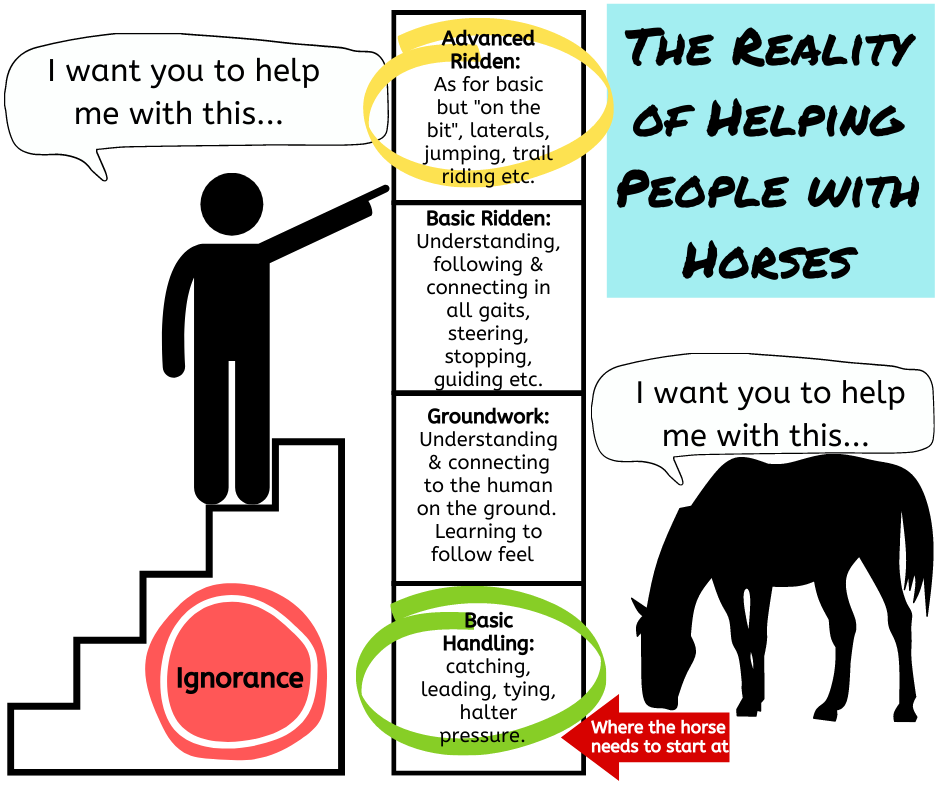Rule #1 - You Start Where the Horse Needs to Start
Rule #1 - You Start Where the Horse Needs to Start
After a life time of helping people with horses Bill Dorrance made this observation…
“Most people don’t realise how important it is to start right down at the foundation level, and work with that horse where he understands….no, they come into horses with other ideas about what’s important to accomplish…”
If you have got yourself frustrated with a horse, lacking progress or ended up in a bad situation, it is most likely because you have broken Rule #1. You have tried to start with a horse at a level way beyond where their understanding and confidence is rock solid. Or you have skipped along too quick. Your agenda has been driven by what you want to accomplish or your expectations instead of the reality that your horse is struggling.
Most of the time it is just ignorance. How horse’s learn and what they need to understand and perform in order to be set up to be a confident riding horse, is poorly appreciated. Just look around the horse world - the bits, devices, restraints, calming powders, problem horse fixes and all the therapies out there for solutions to issues with horses where the root cause can be traced back to confusion.
In all honestly, when I “fix” your horse, I am not really “fixing” them. I am teaching YOU all about Rule #1 and the skills you need to help your horse understand and connect to you!
A common scenario I face is a person who is struggling with their new horse. It might be a young horse or it could be a 15 year old eventing legend. The person might have owned it for 6 weeks or 6 years. But the problem is the same, the person is not working with the horse where the horse needs to start.
When you start a new partnership with a horse it is advisable for you to go back to very basic things and build your relationship from the ground into the saddle. Instead of thinking you can just jump on and ride off.
WHY?
Because horses learn to understand you by reading your body language, movements, how you touch them, sit on their backs, put pressure on the reins, your emotional tone and how all that makes them feel. The horse takes in all this information and works out how to interpret this cacophony of information from their senses. They learn to work you out and what you mean. If you are consistent in how you present yourself it makes it easier for them.
However, the way YOU do things is going to be different from the last person they worked with. For your new horse, you are going to look, move, sound, smell and feel completely different from the previous person they are familiar with. The cacophony of sensations you create is going to be your own mix. A new “language” of the horse to work out. There are very few horses that can cope with such difference without suffering some confusion.
For a horse to understand and trust you they need to be able to work the particular way you present yourself and what you mean. They need time and hours of experience with you to make sense of you. They need to determine you are consistent, predictable and won’t hurt or worry them.
If a horse understands you, finds you predictable and reliable, you set them up to connect to you.
Connection is when they feel secure with you. When they connect the horse will be set up to remaining focused on you. When this happens you can teach them to follow what you are asking them to do above all other pressure or happenings that might trigger their attention or behaviour. The horse will then be set up to remain relaxed out on the trail ride, cope with the barking dog, or motorbike or show atmosphere etc.
When I help people, the biggest barrier to overcome is getting them to appreciate they are trying to start too far up the level of difficulty compared to where the horse is at. They don’t see the point of going back to groundwork and the horse’s foundation. They see this as a backwards step or something unnecessary. They can also see it as time wasting and irrelevant to riding.
From the horse’s perspective the person is just confusing and causing them distress. This is why they anxious, resistant, threatening, braced or reactive to the world around them. They don’t understand you, they don’t trust you and can’t connect to you.
When you work with many horses and you start to appreciate these gentle, highly trainable creatures, you learn there is a quick way and there is a hard way to work with them.
The quick way is to follow Rule #1 and start working with them where they are at. At the level they understand and grow their understanding, confidence and connection. You introduce simple things on the ground and work your way up into the saddle. Do this and you will be where you would like to be in a matter of weeks!
The slow way is to keep pounding into them you are confusing, cause them distress and cannot be trusted. Do this and you will stay here forever. You can even buy a new horse and good chance you will find yourself right back here again!
So, Rule #1 looks like a backwards step. Learning how to build understanding and connection on the ground will take some effort and practice. But it is freedom, not to mention the right thing to do for your horse.
